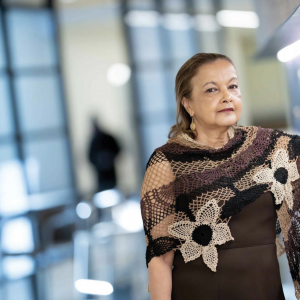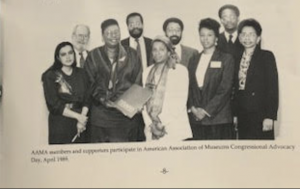
Joy Ford Austin, First Executive Director, AAAM | Years of Service: 1980 to 1987
- What is your fondest memory of working with AAAM?
I would like to elaborate on this question because there are two parts to it at least. One is the sheer awe I felt at being in the same room with intellectuals, civil rights leaders and community organizers wrestling with big questions from the purpose of these museums to how the culture would be presented and how museums could be changed to accommodate what they thought might be most useful. Secondly, I was offered this job when I was just 29 years old and only a naturalized American citizen of 3 years. Dr. Bettye Thomas, then Head of the Bethune Museum and Archives, recruited me. I have to say that my husband was a sociologist and scholar of African American History and Culture and I had already learnt a keen appreciation of African American Culture from him. And I was a reader, I knew even then that I had been given a magnificent opportunity to help create something important that would stand the test of time. So I got to work creating a service organization for black museum professionals and professionals in other museums but in those days the priority was on black museums. That meant developing publications and communication strategies, planning workshops and annual meetings; engaging the field in strategic planning; providing advice and capacity building and serving the Board; and all the tasks that we do as EDs. And fundraising!!!!
- The African American museum field has evolved over time, but still is the pillar of our communities as they educate, inform, and disseminate our history, culture, and art. What museum or cultural institution that you worked with in the past during your time with AAAM, that has continued the work while utilizing the technology and new trends of today?
I am happy to see that many of the core institutions have evolved into extraordinary institutions: DuSable, Wright Museum in Detroit and Anacostia; the African Meeting House in Boston; the college museums like Hampton and Howard; the Great Plains Black History Museum and the Black American West Museum and so many others. Their resiliency amazes me!
- The foundation you laid, allowed for AAAM to have exponential growth over the years. Under our new ED’s leadership, our membership is up 89% from last year, and our conference participation this year alone grew 29% since our attendance last year…did you ever think you’d see the day that AAAM grew to this level?
I truly believe that these are the best years yet for AAAM. Lonnie kept his promise and brought the Association back to DC and housed in the SI, I can feel Vedet’s energy and passion in everything she does and I am not surprised at all at this exponential growth. I am also pleased with the emphasis she places on serving African American professionals in majority institutions. That is an evolution from my days as ED. I hope she and I can develop a closer relationship.
I know that everybody has been kind about my contributions and that Fath and others have mentioned me in their work but I would actually love to have an intern or fellow look at the years between 1980 and 1987.
I also have tapes from several museum leaders that I interviewed between 1997 and 2000. My travel was supported by Kellogg Foundation. And I turned the lessons learned into a Master’s Thesis in 2002. I still hope to complete this project.

AAMA (AAAM) Members and supporters participate in the American Association (American Alliance of Museums) at Museums Congressional Advocacy Day.